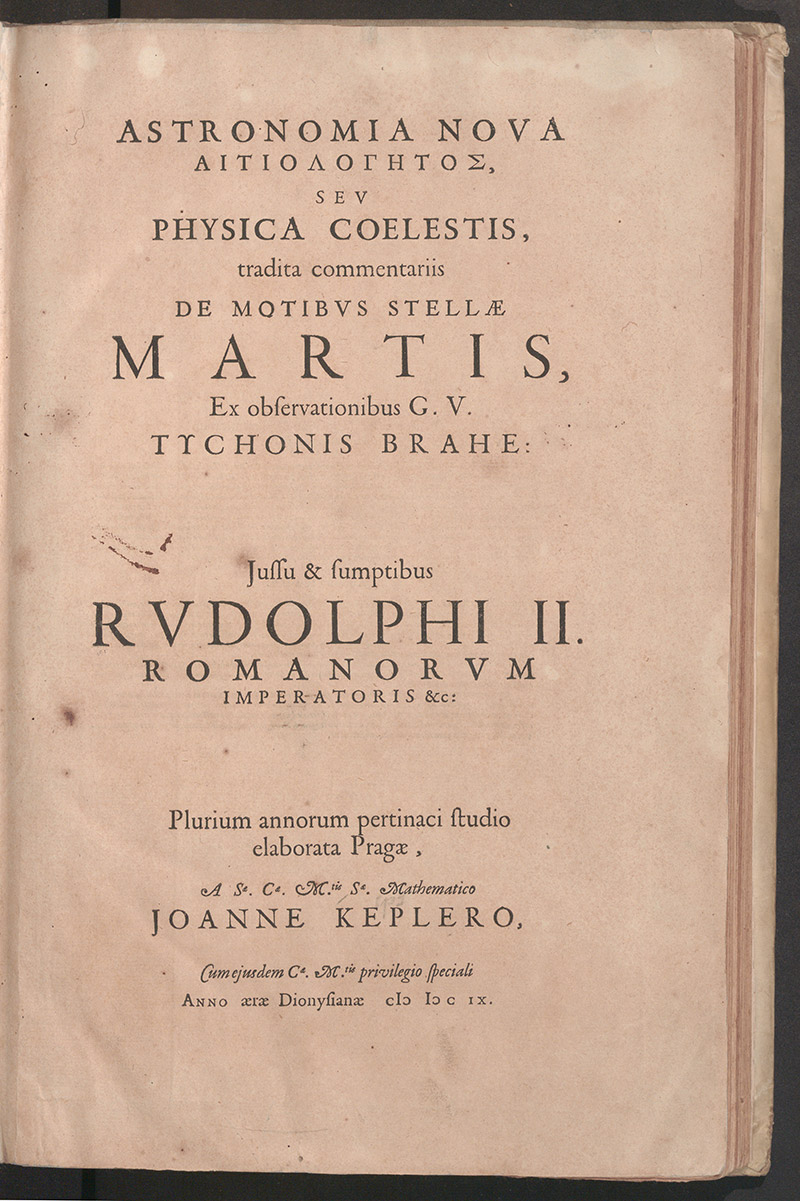The New Astronomy

- Title page.
- Johannes Kepler (1571-1630).
- Astronomia Nova seu physica coelestis, tradita commentariis de motibus stellae Martis, ex observationibus g.v. Tychonis Brahe: iussu & sumptibus Rudolphi II. Romanorvm imperatoris &c: plurium annorum pertinaci studio elaborata Pragae, …
- Prague: 1609.
After the publication of the Mysterium Cosmographicum, Kepler came into contact with Tycho Brahe, the most prominent astronomer of the time. As one of Brahe’s assistants at the observatory of Benátky (a town north of Prague), Kepler was able to check his theory of celestial proportions against observational data. However, Brahe was critical of Kepler’s emphasis on applying dynamical theories to astronomy, preventing him from pursuing research that would support the arguments of the Mysterium Cosmographicum. It was only after the death of Brahe that, as the new royal mathematician, Kepler was able to use Brahe’s astronomical data freely. Thus, Kepler resumed astronomical work based on physics, mostly focusing on the study of the orbit of Mars.
By the end of 1602, Kepler had decided to begin the composition of his Astronomia Nova, which would be published in 1609. At that time, in a letter to the Bavarian Chancellor Herwart von Hohenburg, Kepler explained that his research on Mars had allowed him to resolve the problem of the orbit of the Sun and, therefore, of the Earth. By using his observations of Mars, in the Astronomia Nova Kepler showed that the Earth had a bisected eccentricity, that is, the center of the orbit lay midway between the Sun and the center of motion, making this theory consistent with the theories of the other planets. In short, Kepler introduced three laws. Firstly, the planets move in ellipses, whose movements are determined by the magnetic force of the Sun; to be precise, the speed of the planets is inversely proportional to their distance to the Sun. Secondly, a planet consequently moves irregularly, in such a way that if we draw a line from it, at any point of its orbit, to the Sun, it sweeps out equal areas of the ellipse at equal times. And thirdly, the squares of the periods of the planets around the Sun are proportional to the cubes of the distances.
But the journey leading to the publication of the Astronomia Nova was not an easy one. Since Brahe’s heirs wanted to obtain profit from Brahe’s astronomical legacy, they made every effort to prevent Kepler from publishing work that deviated from Brahe’s conclusions and, therefore, raised Kepler’s scientific reputation. In 1604, Brahe’s son in law, Franz Gansneb Tengnagel van Kamp, and Kepler signed a contract, according to which Tengnagel allowed Kepler access to Brahe’s observational data in exchange for using whatever results Kepler obtained from Brahe’s data. Moreover, Kepler agreed that any publication based on these data should be approved by Tengnagel until the latter published Brahe’s astronomical tables. Consequently, Kepler avoided any attempt by Tengnagel to censor the Astronomia Nova by using a highly conciliatory tone. He would invite his readers to contemplate the traditional theories of Ptolemy and Brahe before proving how physics demonstrated Copernicus’ hypotheses.
Select Bibliography
- Aiton, E. J. 1969. “Kepler’s Second Law of Planetary Motion.” Isis 60: 75-90.
- Gingerich, Owen. 1972. “Johannes Kepler and the New Astronomy.” Quarterly Journal of the Royal Astronomical Society 13: 346-373.
- Gingerich, Owen. 2008. “Kepler, Johannes.” In Complete Dictionary of Scientific Biography, Vol. 7 (digital edition). Detroit, MI: Charles Scribner’s Sons: 289-312.
- Voelkel, James R. 2001. The Composition of Kepler’s Astronomia Nova. Princeton and Oxford: Princeton University Press.
- Wilson, Curtis. 1972. “How Did Kepler Discover His First Two Laws?” Scientific American, 226: 92-106.